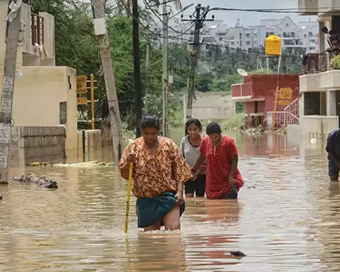 PM Modi visit USA
PM Modi visit USA Only the mirror in my washroom and phone gallery see the crazy me : Sara Khan
Only the mirror in my washroom and phone gallery see the crazy me : Sara Khan Karnataka rain fury: Photos of flooded streets, uprooted trees
Karnataka rain fury: Photos of flooded streets, uprooted trees Cannes 2022: Deepika Padukone stuns at the French Riviera in Sabyasachi outfit
Cannes 2022: Deepika Padukone stuns at the French Riviera in Sabyasachi outfit Ranbir Kapoor And Alia Bhatt's Wedding Pics - Sealed With A Kiss
Ranbir Kapoor And Alia Bhatt's Wedding Pics - Sealed With A Kiss Oscars 2022: Every Academy Award Winner
Oscars 2022: Every Academy Award Winner Shane Warne (1969-2022): Australian cricket legend's life in pictures
Shane Warne (1969-2022): Australian cricket legend's life in pictures Photos: What Russia's invasion of Ukraine looks like on the ground
Photos: What Russia's invasion of Ukraine looks like on the ground Lata Mangeshkar (1929-2022): A pictorial tribute to the 'Nightingale of India'
Lata Mangeshkar (1929-2022): A pictorial tribute to the 'Nightingale of India' PM Modi unveils 216-feet tall Statue of Equality in Hyderabad (PHOTOS)
PM Modi unveils 216-feet tall Statue of Equality in Hyderabad (PHOTOS)The Badminton Association of India (BAI) has announced a 14-member-strong India squad for
- Men’s Sr Hockey Nationals to be played in division-based format from April 4
- Mensik denies Djokovic 100th title in Miami final
- KIPG: Son of a vegetable vendor, Bihar’s Jhandu Kumar eyes Worlds, 2028 Paralympics
- Hardik Singh credits hard work and team unity for receiving HI Midfielder of the Year award
- Djokovic, Alcaraz land in same half of Miami draw
Kolkata needs to cut pollution by 44 per cent Last Updated : 17 Feb 2017 03:02:13 PM IST 
(Fila photo)
The eastern metropolis needs to reduce its annual average pollution levels by 44 per cent to be able to meet the clean air standards, with a special focus on vehicular emissions, an analysis said on Friday.
"The national annual ambient air quality standard is 60 microgram per cubic metre," the Centre for Sciencs and Environment said in a rapid diagnostic analysis that looked into whether key metro cities figure in terms of pollution and carbon footprint of motorisation.
It pointed out that of all the major metro cities in India, Kolkata's transport sector had the smallest pollution and carbon footprint.
However, the analysis warned the city was at "serious risk of losing this advantage" as it was encouraging car-centric planning and infrastructure.
"Kolkata has the highest share (among all metros) of public transport and walking -- 89 per cent of the population uses these modes. It also has the most diverse system of public transport among all metro cities -- bus, metro, tram, suburban rail and waterways. Its policymakers and planners should recognise and leverage this advantage," it said.
In terms of carbon footprint, a car user has 6.5 times more carbon footprint than a two-wheeler rider and 10.6 times more than a bus user, in the city.
"With growing motorisation, this will get worse -- in 2010-12, vehicle registration was in the range of 8-11 per cent; after 2012, this has shot up to 158 per cent," the analysis said.IANS For Latest Updates Please-
Join us on
Follow us on








172.31.16.186







